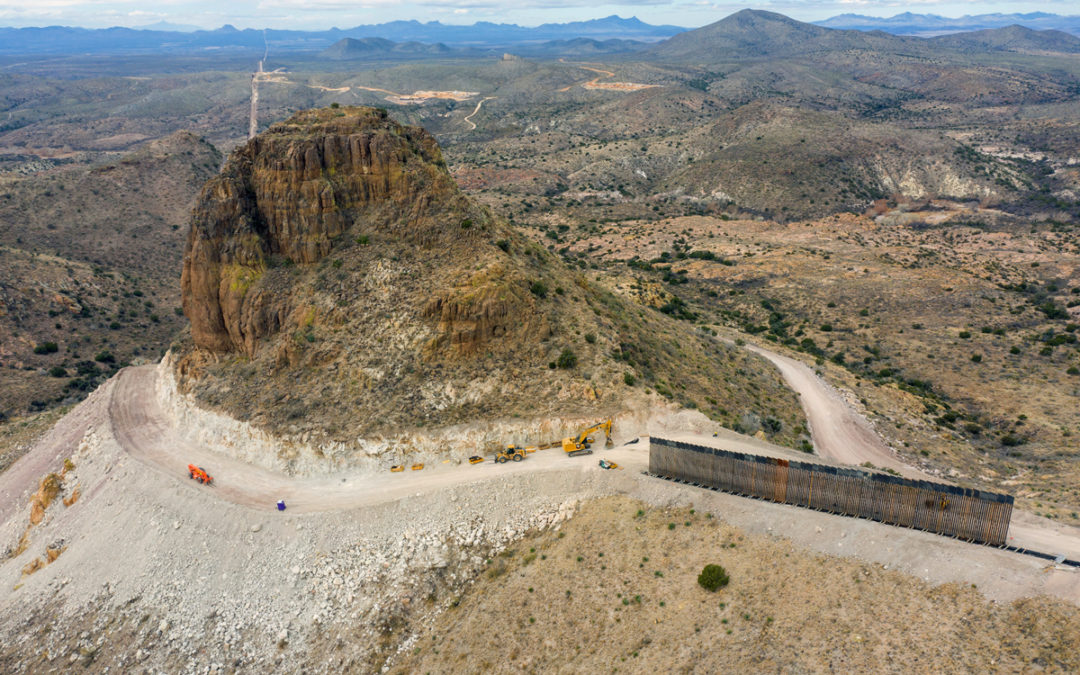SOURCE: High Country News
DATE: February 3, 2021
SNIP: In the last year and a half, crews have raced to complete the border wall promised by President Donald Trump. By the time his term ended, many of the construction projects across Arizona’s Borderlands were complete. As President Joe Biden takes office, environmental groups are taking stock of the environmental destruction caused by the wall as they make the case for restoration.
Much of Arizona’s international border with Mexico is made up of public lands, places set aside by the federal government for special protection because of their unique ecological value — Organ Pipe Cactus National Monument, the San Pedro National Riparian Conservation Area, and Cabeza Prieta and San Bernardino national wildlife refuges, among others. So when the Trump administration released its first plans for new border wall construction in Arizona in May 2019, environmentalists were horrified to see that nearly all the proposed wall segments were on those public lands.
“(The administration) really started to push out into remote, rugged terrain on public lands all across the borderline in Arizona, where the ecological value of those places is so much higher that the damage done by this construction is much more egregious,” said Randy Serraglio, Southwest conservation advocate with the Center for Biological Diversity.
For months now, construction crews have been dynamiting, drilling, pumping, excavating and clear-cutting public land. In places like Guadalupe Canyon in far eastern Arizona, simply building roads to bring in construction equipment involved blasting mountainsides and sending the rubble down to clog drainages. Previously wide-open landscapes where wildlife and water could move freely have been severed by the huge steel barrier. The Sonoran Desert’s iconic saguaros, protected by law, have been found lying in heaps next to construction sites.
“This is damage that will not ever be remediated or mitigated,” Serraglio said. “This is permanent.”
Under the Trump administration, contractors have replaced barbed wire or waist-high barriers with 30-foot-high steel beams, 6 inches wide, with only a 4-inch gap in-between. “Nothing larger than a cottontail rabbit could pass through there,” said Myles Traphagan, Borderlands program coordinator with the Wildlands Network. “So the common wildlife you see along the border, such as javelina, deer, mountain lion, bobcat, bighorn sheep, those are going to be completely impeded by this border wall.”
Traphagan’s organization works closely with ranches in Mexico that prioritize wildlife protection and cross-border migration corridors. He said their game cameras used to capture images of hundreds of animals per month traveling the drainages near San Bernardino National Wildlife Refuge. “But the last few times I’ve been down there, those numbers have just plummeted,” he said.
Then there’s the impacts of water use: In many places, contractors have pumped water from deep below ground for construction purposes, wetting roads to keep the dust down or to make cement. Because Arizona doesn’t require data on water usage from wells in these areas, there are no hard numbers on how much has been used, but some impacts are already clear.
Quitobaquito is a rare desert spring in Organ Pipe Cactus National Monument, located on the ancestral homelands of O’odham tribes. Despite promises from U.S. Customs and Border Protection that the builders would respect a five-mile buffer around the spring and its pond, hydrologists and ecologists who monitor the site said last year that the pond dropped to its lowest levels in years after pumping began for the border wall. Since February 2020, CBP has withdrawn 45 million gallons of water around Organ Pipe Cactus National Monument.
A year ago, hundreds of protesters gathered along the San Pedro River, one of the Southwest’s last free-flowing rivers and a jewel of southern Arizona, to protest the plan to build a border wall across the riverbed. But despite active opposition by environmentalists, local residents and members of Congress, construction continued.
By November, that wall was complete.
“That river is a lifeline for hundreds and hundreds of species; millions of migratory birds use it as a flyway every year,” Serraglio said. “And yet they have constructed a wall right across the riverbed that will almost certainly act as a dam and completely disrupt the normal ecological functioning of that river.”
This is one of the fundamental problems with any recovery or restoration of the Borderlands now that wall construction has ended or been stopped, said Serraglio. In order to speed construction, the Trump administration waived dozens of federal environmental and cultural resource laws that normally apply to such projects — laws that were created to minimize or mitigate their impacts.
“We don’t really have the baseline science to be able to determine what all of the impacts are going to be, because all of the environmental laws that would have required that kind of analysis were waived,” he said.

